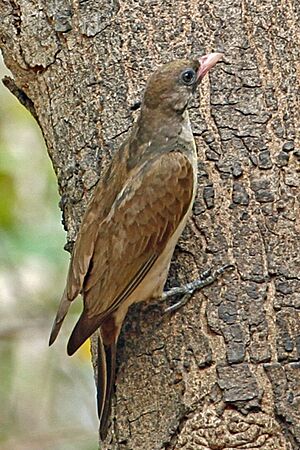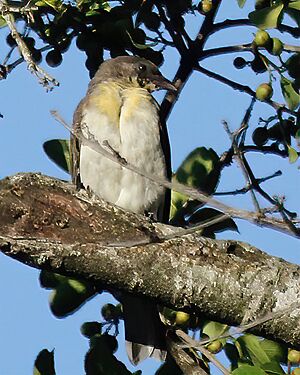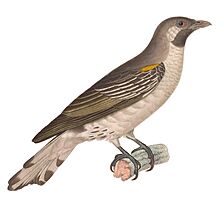Greater honeyguide facts for kids
Quick facts for kids Greater honeyguide |
|
|---|---|
 |
|
| Adult male in Tanzania | |
| Conservation status | |
| Scientific classification | |
| Genus: |
Indicator
|
| Species: |
indicator
|
The greater honeyguide (Indicator indicator) is a fascinating bird found in sub-Saharan Africa. It belongs to the Indicatoridae family, which are birds related to woodpeckers. Its English and scientific names come from its amazing habit of guiding people to wild bee nests. While some people claim it also guides other animals, this idea is debated by scientists.
You can find the greater honeyguide living in many places across Africa. It prefers habitats with trees, especially dry open woodlands. However, it does not live in the dense jungles of West Africa.
Contents
What Does a Greater Honeyguide Look Like?
The greater honeyguide is about 20 centimeters (8 inches) long. It weighs around 50 grams (1.8 ounces). Like all African honeyguides, it has clear white patches on the sides of its tail.
The male bird has dark grey-brown feathers on its upper body. Its underside is white, and it has a black throat. Its wings have whitish streaks, and it has a yellow patch on its shoulder. The male's beak is pink.
The female greater honeyguide looks a bit duller than the male. She does not have the black throat. Her beak is blackish. Young honeyguides look very different. They have olive-brown feathers on their upper bodies. They also have a white rump and a yellow throat and upper chest.
Greater Honeyguide Behavior
What Do Honeyguides Eat?

The greater honeyguide mainly eats things found in bee nests. This includes bee eggs, larvae (young bees), and pupae (bees in their cocoons). They also eat waxworms and beeswax. Honeyguides are one of the few birds that can actually digest wax.
These birds often gather at bee nests. Younger honeyguides tend to be stronger than adults of their own species. They are also stronger than other types of honeyguides. Like other honeyguides, they enter bee nests early in the morning when the bees are less active. They also feed at nests that have been left empty. Sometimes, they scavenge at nests that people or large animals, like the honey badger, have already raided.
How Do Honeyguides Guide People?
The greater honeyguide is famous for leading people to wild bee nests. A guiding bird will get a person's attention with special chattering sounds. These sounds are like "tya" notes mixed with peeps or pipes. The bird makes these same sounds when it's being aggressive.
The guiding bird then flies towards a bee nest. Honeyguides know where many bee nests are in their area. The bird stops near the nest. Then, honey-hunters search for the bee colony. If it looks good, they use fire and smoke to calm the bees. They use axes or machetes to open the nest and collect the honey. After the honey is taken, the honeyguide eats the wax that is left behind.
Studies show that using honeyguides helps people find honey much faster. For example, the Boran people in East Africa cut their honey-finding time by about two-thirds. Because of this, the Boran use a special loud whistle called the fuulido when they start looking for honey. This whistle helps them find honeyguides twice as often.
In northern Tanzania, honeyguides helped the Hadza people find bee nests 560% faster. The birds also led them to nests with much more honey. Another study in Mozambique found that honeyguides responded to the traditional "brrrr-hmm" call of the Yao honey-hunters. Using this call greatly increased the chances of finding a bee-hive. Yao hunters said that only adult honeyguides respond to these calls, not young ones.
In African stories, people often say you should thank the honeyguide with some honey. If you don't, it might lead you to a lion, a large elephant, or a venomous snake as punishment. However, some people believe giving them honeycomb spoils the bird. They think it's better to let the bird find its own wax bits. The Hadza people sometimes burn or hide the wax. They do this to keep the bird hungry so it will guide them again. In some parts of Kenya, some honeyguides have stopped guiding people. This is because people in those areas no longer respond to their calls.
Do Honeyguides Guide Other Animals?
Many sources say that the greater honeyguide also guides honey badgers. In the 1700s, Sparrman wrote that African people reported this. However, no biologist has ever actually seen it happen. Some reports say honeyguides guide baboons. Scientists have wondered if this guiding behavior first developed with these animals before humans appeared.
However, scientists still doubt that honeyguides guide other animals. They suggest that this behavior might have developed with early humans instead. Later studies suggest that interactions between honeyguides and honey badgers might happen. But if they do, they are very rare or hard to see. Also, bee colonies are common in Africa, so honey badgers probably don't need help finding them.
Another reason to doubt that honeyguides guide other animals is that near cities, where people buy sugar instead of hunting for wild honey, the guiding behavior is disappearing. Eventually, it might disappear everywhere.
Greater Honeyguide Life Cycle
The greater honeyguide is not only a bird that eats insects and helps humans. It is also a brood parasite. This means it lays its eggs in the nests of other bird species. It lays white eggs, usually 3 to 7 at a time, for a total of 10 to 20 eggs in a year. Each egg is laid in a different nest.
The host birds include some woodpeckers, barbets, kingfishers, bee-eaters, wood hoopoes, starlings, and large swallows. The female greater honeyguide often breaks the host's eggs when she lays her own. All the birds that honeyguides parasitize nest in holes, covered nests, or deep cup nests.
When a honeyguide chick hatches, it has a special hook on its beak. Even though it is still blind and has no feathers, it uses this hook to kill the host's young. It does this by repeatedly wounding them.




